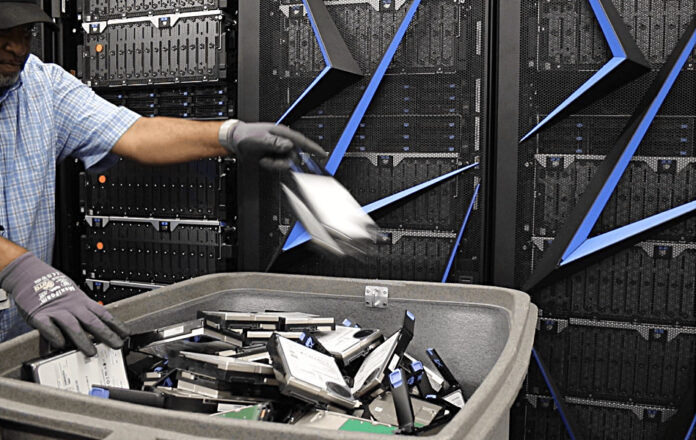Used Seagate EXOS drives presented as new are being sold through online retail channels, duping both buyers and sellers. The storage biz has now launched an investigation to find out what happened and is warning customers to be mindful of the warranty implications.
This follows a recent rise in the number of customers reporting drive fraud after used devices sold as new found their way into the authorized supply chain, according to a report by Heise in Germany. The drives indicated a runtime of zero hours yet tests showed that some had been in operation for an average of 25,000 hours.
This could be done by hacking the drive’s SMART data, and it is claimed that BAB Distribution and ctn-systeme in Germany, Digitec-Galaxus from Switzerland, DiTech from Austria, the Luxembourg branch of Alternate, and some Amazon and eBay retailers were unwittingly caught out, though they have offered to replace the dirves or refund the purchase price. Resellers Bechtle and Wortmann had been similarly duped, it was reported by the German media outlet.
In a statement, Seagate said:
“Seagate has not sold or distributed these mislabeled drives to retailers. We recommend that retailers purchase drives only from certified Seagate distribution partners to ensure they are purchasing and selling only new or Seagate factory recertified drives. Drives refurbished by Seagate, factory certified and resold under the Seagate Drive Circularity Program can be identified by the green-bordered white drive label and the designation ‘Factory Recertified.'”
Segate told Block and Files: “These are clearly used drives that are fraudulently sold as new drives on the open market. So the buyer gets these drives, they’re clearly used. They bought them at a new price and that is what is happening from what we can tell early in this investigation. The majority of those drives, so they’ve come from an OEM or they come from a cloud provider, they’ve been pulled and then they’ve sold out on the open market as new. Those are clearly fraudulent drives.”
Seagate says it also knows of cases of blatant deception – drives “which might consist of what we call outright fraud, which are counterfeit labels. It’s not unusual for customers to get a counterfeit drive and that might be a drive of a different class remarketed as a higher class, like an EXOS category to command a higher price. We see outright drives that often come in with no guts inside. Basically they’re a paperweight. So we occasionally run into a few of those, not widespread, but occasionally.
“So we really want to try to make sure customers know who they’re buying them from and use our tools to validate that their parts and that the product they bought is in warranty. So in the case of what we’re seeing in the fraud [highlighted by Heise], again, those are largely used drives sold as new. We also see some counterfeit labels where country names aren’t spelled correctly. There’s a whole host of things that you can start to identify in a label that are pretty good indicators of fraud.
“We have a security and brand council. We engage authorities and we’ll take down resellers where we’ve identified fraudulent activities. And if they’re resellers of ours, we try to proactively work with them. And a lot of times in the majority of cases, they’re unaware that they have this fraudulent inventory. So we work with them on trying to identify where they source that from and correct that with those parties that have been identified.
“We’ve actually even had a third-party investigative firm that’ll continue to conduct these buys on our behalf and then take any necessary legal actions required. So we take this very seriously. We hate to see our customers being the recipient of these fraudulent drives. We try to make it right.”
Seagate sells new and reconditioned drives. Both are warranted, but the reconditioned drives are only for six months or so, much less than new drives. New drives are sold through a two-tier distribtion channel (wholesaler to reseller), as well as to OEMs, systems integrators, and hyperscalers. The distributors are located within geographic regions and drive warranties are specific to these regions.
A Seagate spokesperson told Blocks and Files: “Those resellers, the vast bulk of them will buy first-party drives from their distributors for obvious reasons. They get a good price, they’re trustworthy, they have backup, they have support, so on and so forth. But there’ll be some who may buy drives from somewhere else. This is not something that Seagate can prevent even if it wished.”
A diagram shows what’s going on:

OEMs and system integrators (SIs) treat drives as components, building systems using them, like servers, and then supplying the systems either to distributors who then sell to resellers, directly to resellers, or directly to larger customers.
A regional supplier may wish to sell off an inventory of unwanted drives; perhaps ones with too low a capacity for their current customers, and offer them at a lower price to resellers. This can be an attractive price to both in-region and out-of-region resellers or etailers who buy the drives to sell on, but Seagate then deems that their warranty has been invalidated by the drive being sold out of its original region.
“Drives that are new legitimate drives, but they are sold outside of their region… are not eligible for warranty in a region other than where they were sold. So typically, we will see gray market, in particular for markets like China. We are working very closely to make sure that those clearly say China-only.”
“Those are typically new drives [and] not an issue, except when a customer buys them from out-of-region, they’re looking for a deal, they’ll quickly realize should they have an issue that those are not eligible for return in a region that they were sold. So that’s not uncommon.”
Customers with a population of used but no longer wanted drives can destroy them or return them to Seagate, which will either destroy them or, if they still have a useful working life, refurbish them and sell them explicitly as reconditioned drives with “Re-certified” on a white label, and etched “Re-certified” on the casing base. Such drives are sold to online channels and you may find them, for example, on eBay.
The Seagate spokesperson told us these are called pulled drives. “Those are typically used drives that have come from an OEM or a hyperscaler or another region. Those were integrated, subsequently used, and then pulled out. And typically when they’re pulled, most companies will either destroy them or they will resell them on the market, but should advertise [them] as such.” This happens “in the majority of these cases.”
“You might have resellers that warranty those products for a longer period of time. That’s at their discretion, but it’s important the public knows we warranty those drives for only six months.
”In general, we’ve had a second-hand market for a very long time. I think it’s really proliferated with etail and the ability to have third party marketplaces that can sell. I think eBay is one of the marketplaces [where] we see a lot of third party activity. Even Amazon 3P (third party) continues to grow, and so it’s really important buyers are aware of who that third party it is. We encourage them to buy first-party material because that is what we sell to Amazon. That is legitimate. Anything that comes through third party, make sure you’re buying from a reputable seller on Amazon.”
It’s a case of buyer beware. “In the event that they’ve caught… not only do we encourage them to return that, more importantly, we actually ask them to report it. Because what often happens is someone might identify a used drive sold as new, they return it, that stays in the supply chain and we’re not able to pull that out of the supply. It gets put back into circulation. So we actively encourage them to report that to us and actually return the drive to us. We have a program in place that allows them with proof of purchase and that securing that drive, we will replace that drive for them.”
Bootnote
Heise reports some customers buying Western Digital drives may have been similarly deceived. We have asked Western Digital for comment.








